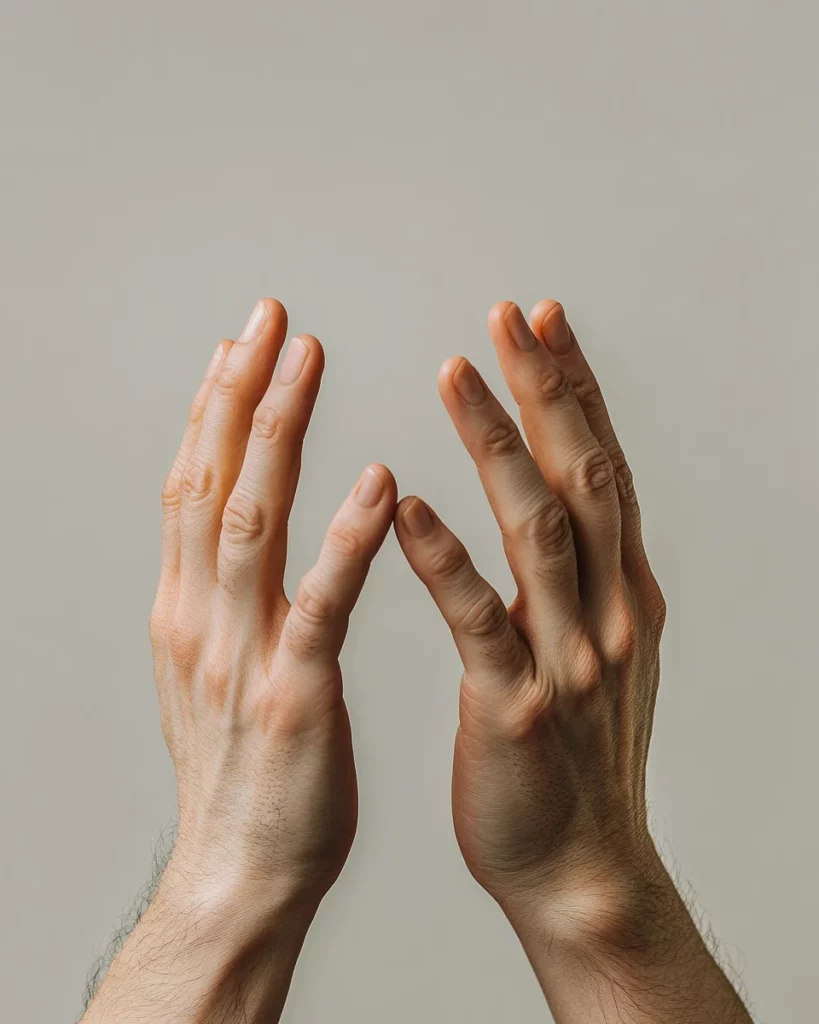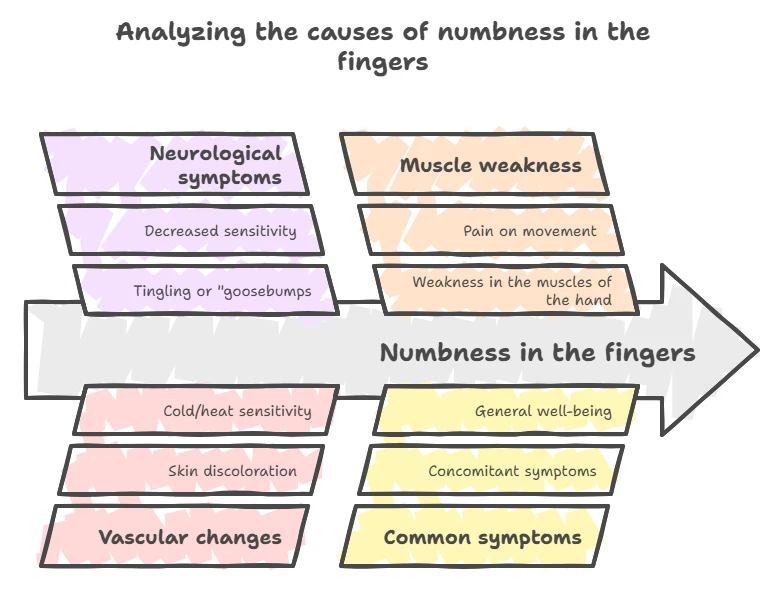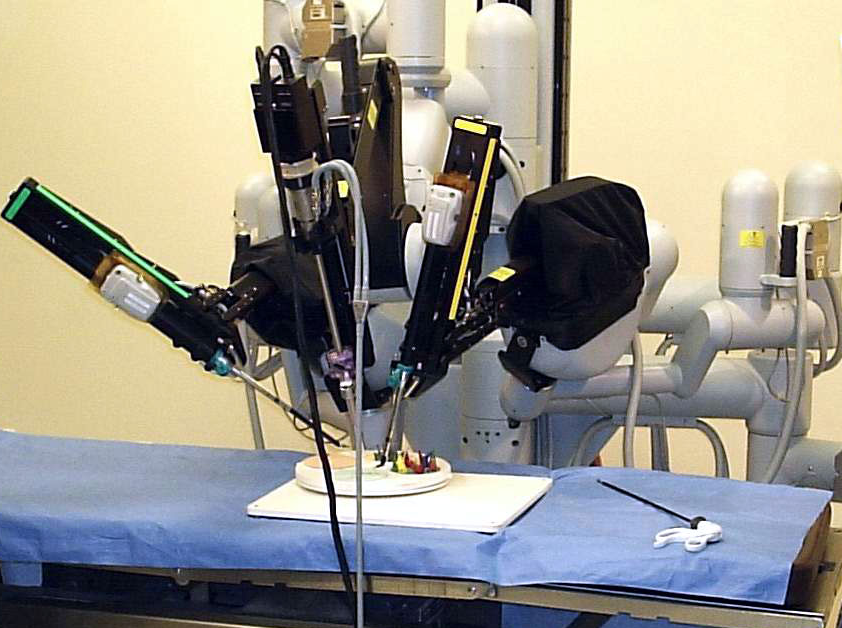

The sensation of numbness (paresthesia) in the fingers may occur suddenly or be chronic. Sometimes it is accompanied by tingling, “goosebumps” and even pain. Such manifestations can occur in various conditions – from trivial nerve compression to serious diseases of the nervous system and blood vessels.
Important: If numbness persists for a long time (several days) or is accompanied by severe pain, loss of sensation, movement disorders, you should always consult a doctor.

Main causes of finger numbness
Numbness can be caused by a variety of factors. Let’s look at the most common ones:
- Circulatory disorders
- Raynaud’s syndrome: a vascular disorder in which the blood vessels become severely constricted in response to cold or stress, leading to numbness in the fingertips.
- Atherosclerosis: blockage of blood vessels by cholesterol plaques can affect the blood supply to the extremities.
- Hypotension (low blood pressure) or anemia can also cause impaired blood flow.
- Neurological causes
- Carpal tunnel syndrome (carpal tunnel): compression of the median nerve in the wrist. More common in people who work a lot at a computer or perform monotonous hand movements.
- Cervical osteochondrosis and radiculopathy: spinal problems in the neck area can lead to compression of the nerves to the hands.
- Pinched ulnar nerve (cubital tunnel): often accompanied by numbness in the little and ring finger.
- Endocrine and metabolic disorders
- Diabetes mellitus: often causes polyneuropathy, in which sensitivity of the limbs is impaired.
- Hypothyroidism (lack of thyroid hormones) can also affect the nervous system.
- Vitamin deficiencies
- B vitamins (especially B6, B12) play an important role in the transmission of nerve impulses. Their deficiency can cause numbness.
- Injuries and overload
- Damage to nerves and blood vessels as a result of blows, sprains, fractures.
- Excessive strain on the hands in sports, work or hobbies (knitting, playing musical instruments).

Symptoms and Recognition
Numbness may affect one or more fingers. When diagnosing, it is important to pay attention to the accompanying manifestations:
- tingling or “goosebumps”;
- skin discoloration (pallor, blueness, redness);
- pain that increases with movement;
- weakness in the muscles of the hand;
- decreased sensitivity to cold or heat.
Table 1. Common causes of numbness for specific fingers
| Fingers | Possible causes |
|---|---|
| Thumb | Carpal tunnel syndrome, cervical osteochondrosis. |
| Index | Carpal tunnel syndrome, neurological disorders |
| Medium | Carpal tunnel syndrome, radiculopathy. |
| Nameless | Cubital tunnel (ulnar nerve), vascular problems. |
| Littlefinger | Cubital tunnel, elbow injuries |
If numbness increases at night or in the morning, it is worth paying attention to your pillow and the position of your arms during sleep: incorrect positioning of the neck and shoulders can contribute to nerve compression.

Prevention
To reduce the likelihood of numbness in the fingers, it is useful to follow simple recommendations:
- Moderate physical activity
– Daily exercises to stretch the muscles of the shoulders and hands.
– Try to take regular breaks if you have to sit at a computer for a long time or perform monotonous activities with your hands. - Circulatory Care
– Avoid extreme temperature changes.
– Avoid wearing tight clothing or accessories that constrict blood vessels.
– Monitor cholesterol and blood pressure. - Proper nutrition
– Take sufficient amounts of B vitamins.
– Make sure your diet is balanced and avoid severe restrictive diets without specialist advice. - Proper workplace
– Correctly adjust the height of your chair and desk top.
– Use an ergonomic keyboard and mouse.
– Maintain a straight posture while working.
Treatment and self-help
For occasional numbness that is not associated with a serious pathology, you can try the following:
- Therapeutic exercise and massage
– Massage the hands and forearms in circular motions using warming ointments or oils.
– Perform hand stretching exercises (e.g., slowly clenching and unclenching your fist). - Pharmaceuticals
– Nonsteroidal anti-inflammatory drugs (for inflammation).
– Vitamin complexes (B6, B12).
– Ointments based on NSAIDs (diclofenac, ibuprofen) for pain.
– Vasodilators may be prescribed by a doctor for blood flow disorders. - Physiotherapy
– Electrophoresis with medications.
– Magnetotherapy or ultrasound therapy to improve microcirculation and reduce inflammation. - Lifestyle correction
– Control of blood sugar levels (especially in diabetes).
– Balanced diet with sufficient protein and healthy fats.
Table 2. Recommended exercises for numbness
| Exercise | Description | Number of repetitions |
|---|---|---|
| Clenching and unclenching of the fist | Slowly clench your fist and hold for 3-5 seconds, then unclench it | 10-15 repetitions |
| Wrist stretch | Extend the arm forward, with the other hand gently pull the hand backward | 5-10 repetitions for each arm |
| Circular brush movements | Keeping the arm bent at the elbow, rotate the hand clockwise and counterclockwise | 10 laps each way |
| Light self-massage of the palm and fingers | Use circular motions, can be applied with cream/oil | 3-5 minutes for each arm |
When to see a specialist
-
- If numbness persists for more than a few days and does not go away after simple measures described above.
- When there is severe pain, weakness in the hands, impaired coordination of movements.
- When accompanied by general symptoms: fever, general malaise, sudden spikes in blood pressure.
- When a nerve injury or pinched nerve is suspected.
Tip: Consult your general practitioner or neurologist. If necessary, your doctor may recommend consultations with an endocrinologist, orthopedist or vascular surgeon.
Conclusion
Numbness in the fingers of the hands can be both a temporary discomfort associated with incorrect posture or overload, and a sign of serious diseases. Timely diagnosis and a comprehensive approach to prevention and treatment help to get rid of unpleasant sensations and preserve the health of hands. In case of persistent and intense numbness, as well as in the presence of alarming symptoms, you should immediately contact a medical specialist.
List of references
- Carpal Tunnel Syndrome. National Institute of Neurological Disorders and Stroke (NINDS)
- Ulnar Neuropathy at the Elbow. National Library of Medicine (NCBI)
- Shmerling R.H., “Evaluation of the patient with hand numbness”. UpToDate, 2022.
- Peripheral Neuropathy. Mayo Clinic
- Слинько О. А., “Дефицит витаминов группы В у пациентов с полинейропатией: диагностика и терапия”, Український медичний часопис, 2021.



